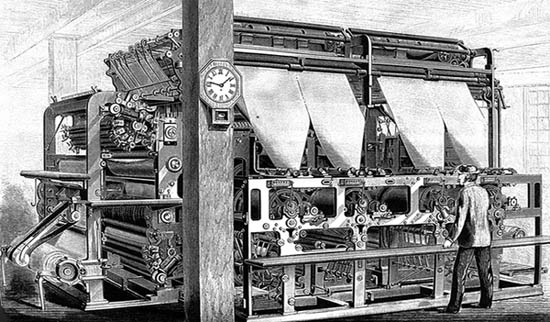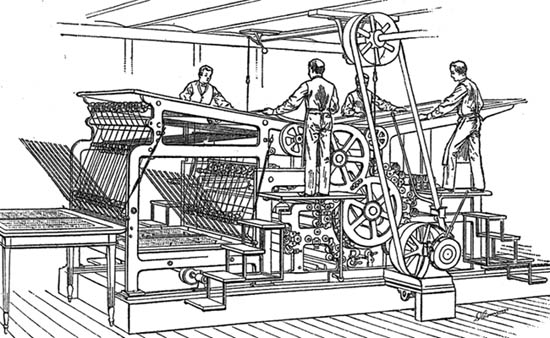Web-Fed Press
Today, speed outruns us. The University of Houston's College of Engineering presents this series about the machines that make our civilization run, and the people whose ingenuity created them.
I've mentioned the19th-century print revolution before. A series of improved hand presses had finally gone beyond the presses used by both Gutenberg and Ben Franklin. But they still pressed one sheet of paper at a time against inked type -- not good enough for a public that cried out to have cheap and available books.
Finally, in 1810, German inventor Friederich Koenig built a steam-powered cylinder press that printed sheets of paper flowing through its rollers. Throughout the mid-19th century, a dizzying array of cylinder machines sped the flow of printed paper sheets to thousands per hour.
And those weren't just pages, those sheets, printed on both sides, would fold into signatures of maybe 16 pages. A book that would've taken most of a day to print on a hand press could now be printed in, not minutes, but seconds.
Then the so-called web-fed press really sped output. You've watched one of those if you've ever visited a newspaper press -- a huge roll of paper feeding a machine that covers the length of a factory floor. Paper flows in one end and, every second, dozens of folded newspapers come out the other.
The genius behind this was Richard Hoe. Born in 1812, Hoe was raised in a family deeply involved with the new fast presses. In 1846, he built a new press which, instead of using rollers to press flat paper against flat type, held type on curved rollers.
But that was just the beginning. Others had tried means for feeding a press with paper rolls instead of single sheets. Hoe bought up patents of other people's idea and he fused them into the first fully-evolved press fed by a paper roll. That was 1873.
Three years later, web-fed machines equipped with folding apparatus could handle 15,000 folded signatures per hour. Soon, presses more than doubled that output; but here an old technological limitation arose. I offer an analogy.
Speed was our great desire two centuries ago. We went from seven mile-an-hour steamboats to rocket-powered airplanes. Then speed outran utility. As the airport, not the airplane, limited our speed of travel, we quit building for speed. Now we focus on the beginning and end of our journey. (Remember how SSTs came and went.)
So too with the web-fed press: All my later books have been made on web-fed presses that deliver maybe 15,000 printed signatures per hour. At that rate, the whole print run takes only a few hours. It takes longer to set the press up for the run, and to get the inking process stabilized, than it does to print the book.
There's more. The startup process for a web-fed press wastes a lot of paper. That's tolerable for large runs -- especially for newspapers. But, for small print runs, the printer goes back to modern forms of the older sheet-fed press.
Technology is a strange beast. We push it and push it, and often reach the end of our tether only after we've pushed it beyond the brink of utility.
I'm John Lienhard, at the University of Houston, where we're interested in the way inventive minds work.
J. Moran, Printing Presses: History and Development from the fifteenth Century to Modern Times. (Berkeley: Univ. of California Press, 1973).
For more on the 19th-century print revolution, and on the 19th-century quest for speed, see J. H. Lienhard, How Invention Begins: Echoes of Old Voices in the Rise of New Machines. (New York: Oxford University Press, 2006).
I am very grateful to Richard Hollick and Helen Mules of Oxford University Press for their valuable counsel.

The Hoe Sextuple Press, possibly the world's largest web-fed press in 1892, It could deliver many as 24,000 large signatures per hour.

This "Rotary Art Press" was a large Hoe single-sheet machine. (Both images are from Appelton's Cyclopaedia of Applied Mechanics, 1892